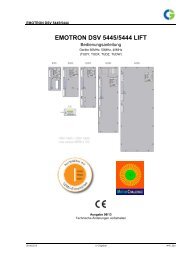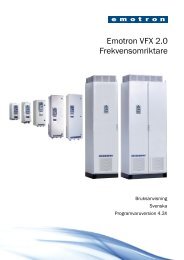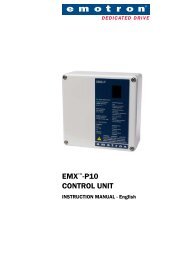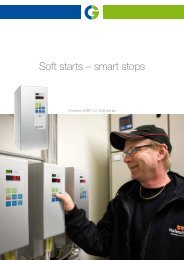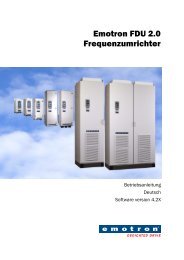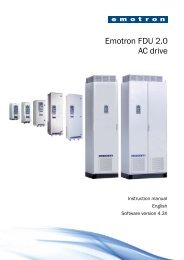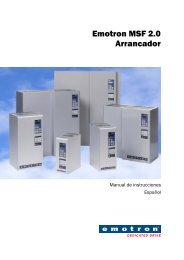Emotron MSF 2.0 Fieldbus Option
Emotron MSF 2.0 Fieldbus Option
Emotron MSF 2.0 Fieldbus Option
Create successful ePaper yourself
Turn your PDF publications into a flip-book with our unique Google optimized e-Paper software.
<strong>Emotron</strong> <strong>MSF</strong> <strong>2.0</strong><br />
<strong>Fieldbus</strong> <strong>Option</strong><br />
Instruction manual<br />
English
Valid for the following models:<br />
EMOTRON <strong>Fieldbus</strong><br />
<strong>Fieldbus</strong> <strong>Option</strong><br />
Instruction Manual - English<br />
Document number: 01-5927-01<br />
Edition: r0<br />
Date of release: 2012-03-01<br />
© Copyright CG Drives & Automation Sweden AB 2012.<br />
CG Drives & Automation Sweden AB retain the right to change specifications<br />
and illustrations in the text, without prior notification. The<br />
contents of this document may not be copied without the explicit<br />
permission of CG Drives & Automation Sweden AB.
Safety<br />
Instruction manual<br />
It is important to be familiar with the softstarter to fully understand this<br />
instruction manual.<br />
Technically qualified personnel<br />
Installation, commissioning, demounting, making measurements, etc. of or on<br />
the <strong>Emotron</strong> products may only be carried out by personnel technically qualified<br />
for the task.<br />
Installation<br />
The installation must be made by authorised personnel and must be made<br />
according to the local standards.<br />
Opening the softstarter<br />
DANGER!<br />
ALWAYS SWITCH OFF THE MAINS VOLTAGE BEFORE<br />
OPENING THE UNIT.<br />
Always take adequate precautions before opening the softstarter. Although the<br />
connections for the control signals and the jumpers are isolated from the mains<br />
voltage. Always take adequate precautions before opening the softstarter.<br />
EMC Regulations<br />
EMC regulations must be followed to fulfil the EMC standards.<br />
CG Drives & Automation 01-5927-01r0<br />
Safety
Safety<br />
CG Drives & Automation 01-5927-01r0
Contents<br />
Safety ..................................................................................................... 1<br />
1. Quick Set-up................................................................................ 3<br />
2. General........................................................................................ 5<br />
2.1 Introduction................................................................................................. 5<br />
2.2 Description.................................................................................................. 5<br />
2.3 Users............................................................................................................ 5<br />
2.4 Safety........................................................................................................... 6<br />
2.5 Delivery and Unpacking.............................................................................. 6<br />
3. FieldBus I/O................................................................................ 7<br />
3.1 Introduction................................................................................................. 7<br />
3.2 HMS ............................................................................................................. 7<br />
3.3 Interfaces of communication..................................................................... 7<br />
3.4 Setting up.................................................................................................... 8<br />
3.5 Description of Jumpers and LED´s ........................................................... 8<br />
3.6 Recommendation ....................................................................................... 9<br />
4. ProfiBus - Dp ............................................................................. 11<br />
4.1 Introduction.............................................................................................. 11<br />
4.2 Setting up................................................................................................. 11<br />
5. DeviceNet.................................................................................. 13<br />
5.1 Introduction.............................................................................................. 13<br />
5.2 Setting up................................................................................................. 13<br />
6. RS-232....................................................................................... 17<br />
6.1 EmoSoftCom ............................................................................................ 17<br />
6.2 Modbus RTU and RS-232 ....................................................................... 17<br />
6.3 Modes....................................................................................................... 17<br />
6.4 RS-232 Connection ................................................................................. 18<br />
CG Drives & Automation 01-5927-01r0 1
7. <strong>Emotron</strong> <strong>MSF</strong> <strong>2.0</strong> ..................................................................... 19<br />
7.1 Response time.......................................................................................... 19<br />
7.2 Installation in <strong>Emotron</strong> <strong>MSF</strong>-017 to <strong>MSF</strong>-145 ....................................... 19<br />
7.3 Installation in <strong>Emotron</strong> <strong>MSF</strong>-170 to <strong>MSF</strong>-1400..................................... 21<br />
7.4 Set-up Communication Parameters........................................................ 24<br />
7.5 Selection of control sources .................................................................... 27<br />
7.6 Using serial comm. with <strong>Fieldbus</strong>............................................................ 28<br />
7.7 Using serial communication with RS-232 Modbus RTU ........................ 28<br />
7.8 Map ........................................................................................................... 29<br />
7.9 Getting started - simple communication example ................................. 34<br />
2 CG Drives & Automation 01-5927-01r0
1. Quick Set-up<br />
Following flowchart is a step by step guide for advanced users, with references to<br />
chapters with detailed information.<br />
Set FieldBus I/O Address<br />
- Profibus, see 4.2.3<br />
- DeviceNet, see 5.2.3<br />
Set FieldBus I/O Baudrate<br />
- Profibus, automatically selected<br />
- DeviceNet, see 5.2.4<br />
Set internal Communication Address<br />
- <strong>MSF</strong>, use address 1, see 7.4<br />
Set internal Communication Baudrate<br />
- <strong>MSF</strong>, use 19.2 kBaud, see 7.4<br />
Set Internal Communication Parity<br />
- <strong>MSF</strong>, use No Parity, see 7.4<br />
Set Control Mode<br />
- <strong>MSF</strong>, parameter 200, use mode 3,<br />
see 7.5<br />
Fig. 1<br />
Step by step guide.<br />
CG Drives & Automation 01-5927-01r0 Quick Set-up 3
4 Quick Set-up CG Drives & Automation 01-5927-01r0
2. General<br />
2.1 Introduction<br />
The FieldBus I/O interface allows external equipment to exchange data and run<br />
our products.<br />
The FieldBus I/O interface acts as a slave in a master slave configuration.<br />
Physical connection can be either RS-232 or one of the available fieldbuses.<br />
2.2 Description.<br />
This instruction manual describes the installation and operation of the FieldBus<br />
I/O option card, which can be built into the following products:<br />
<strong>MSF</strong> <strong>2.0</strong> Softstarters:<br />
<strong>MSF</strong>-017 - <strong>MSF</strong>-1400<br />
Specific information about the softstarters is in chapter 7. page 19.<br />
2.3 Users<br />
This instruction manual is intended for:<br />
• Installation engineers<br />
• Designers<br />
• Maintenance engineers<br />
• Service engineers<br />
• Programmers<br />
CG Drives & Automation 01-5927-01r0 General 5
2.4 Safety<br />
Because this option is a supplementary part of the softstarter, the user must be<br />
familiar with the original instruction manual of the <strong>MSF</strong> <strong>2.0</strong> softstarter. All<br />
safety instructions, warnings etc. as mentioned in this instruction manual are to<br />
be known to the user.<br />
The following indications can appear in this manual. Always read this first and<br />
be aware of their content before continuing.<br />
NOTE: Additional information as an aid to avoiding problems.<br />
CAUTION!<br />
Failure to follow these instructions can result in malfunction or damage to<br />
the softstarter.<br />
WARNING!<br />
Failure to follow these instructions can result in serious injury to the user in<br />
addition to serious damage to the softstarter.<br />
2.5 Delivery and Unpacking.<br />
Check for any visible signs of damage. Inform your supplier immediately of any<br />
damage found. Do not install the option card if damage is found.<br />
If the option card is moved from a cold storage room to the room where it is to<br />
be installed, condensation can form on it. Allow the option card to become fully<br />
acclimatised and wait until any visible condensation has evaporated before<br />
installing it in the softstarter.<br />
6 General CG Drives & Automation 01-5927-01r0
3. FieldBus I/O<br />
3.1 Introduction<br />
The FieldBus I/O <strong>Option</strong> consists of 2 parts. One part is an AnyBus I/O<br />
Module. This module is a third part and comes from HMS.<br />
We have chosen to buy this part because of the complexity and amount of<br />
fieldbuses.<br />
3.2 HMS<br />
This is how HMS present themselves:<br />
" HMS develops and supplies high tech electronics to quality conscious<br />
customers worldwide. HMS was one of the first companies to develop interfaces<br />
for all major fieldbus systems. Today, ten years later, we have expanded both the<br />
technology and our own skills. We are now one of the world’s leading<br />
companies in the fieldbus technology sphere, and are the global leaders in<br />
embedded OEM fieldbus modules for industrial products. "<br />
3.3 Interfaces of communication<br />
Fig. 2<br />
Ways to communicate<br />
CG Drives & Automation 01-5927-01r0 FieldBus I/O 7
3.4 Setting up<br />
Several steps must be done for a complete set-up. Both FieldBus I/O <strong>Option</strong><br />
and the softstarter must be set for a complete and working system. The FieldBus<br />
I/O <strong>Option</strong> is also divided into 2 parts; FieldBus and RS-232.<br />
3.5 Description of Jumpers and LED´s<br />
J2<br />
64 32<br />
COM.FAILURE<br />
RUN<br />
TESTMODE2<br />
TESTMODE1<br />
FIELD-<br />
BUS RS-232<br />
J1<br />
Fig. 3 Jumper 1<br />
3.5.1 Mode<br />
User can choose between RS-232 and FieldBus with jumper J1. It is not<br />
possible to communicate in both ways at the same time.<br />
8 FieldBus I/O CG Drives & Automation 01-5927-01r0
3.5.2 LED indication<br />
Four LED´s indicates what status the FieldBus I/O <strong>Option</strong> have.<br />
LED 1 and 2 are only for internal use at production.<br />
LED 3 (green) indicates that the FieldBus communication is working and<br />
running.<br />
LED 4 (red) indicates that external communication is broken.<br />
LED 3 and 4 (red and green) indicates that the FieldBus I/O <strong>Option</strong> is trying to<br />
achieve internal communication with the product. This state is seen when the<br />
product is started. If the product is not correct set the <strong>Fieldbus</strong> I/O <strong>Option</strong> will<br />
remain in this state.<br />
3.6 Recommendation<br />
We suggest that installation, cables and connectors must be followed as specified<br />
by each fieldbus organisation.<br />
CG Drives & Automation 01-5927-01r0 FieldBus I/O 9
10 FieldBus I/O CG Drives & Automation 01-5927-01r0
4. ProfiBus - Dp<br />
4.1 Introduction<br />
PROFIBUS-DP is designed for high-speed data communication at the device<br />
level. Here, central controllers (e.g., PLC’s/PC’s) communicate with their<br />
distributed field devices (I/O, drives, valves, etc.) via a high-speed serial link.<br />
Most of the data communication with these distributed devices is done in a<br />
cyclic manner. The functions required for these communications are specified<br />
by the basic PROFIBUS-DP functions in accordance with EN 50 170.<br />
4.2 Setting up<br />
Before commencing communication with the FieldBus I/O option, the option<br />
and the product will need some settings. For product settings information see<br />
the product specific chapters.<br />
4.2.1 Picture of interface<br />
Terminating resistor<br />
Connection LEDS S3 S2<br />
Address<br />
X10 X1<br />
Fig. 4<br />
Profibus interface.<br />
4.2.2 Connection<br />
Table 1<br />
9-pin D-sub connector.<br />
D-sub<br />
Description<br />
8 A-Line<br />
3 B-Line<br />
Housing<br />
Shield<br />
5 GND<br />
6 Vcc<br />
4 RTS<br />
CG Drives & Automation 01-5927-01r0 ProfiBus - Dp 11
4.2.3 Address<br />
Address can be set from 00 to 99 by rotary switches S2 and S3. To calculate the<br />
address, multiply S3’s value by 10 and then add the values.<br />
4.2.4 Baudrate<br />
The baudrate is automatically selected from 9600 Baud to 12M Baud.<br />
4.2.5 Termination<br />
Termination of the fieldbus requires a terminating resistor at each end of the<br />
fieldbus. Switching S1 to ON can connect the termination resistor.<br />
4.2.6 Led indication<br />
Table 2<br />
LED indication<br />
Led Colour Function<br />
Error Red Bus off/error<br />
DIA Green Not implemented<br />
Power Green Power on<br />
12 ProfiBus - Dp CG Drives & Automation 01-5927-01r0
5. DeviceNet<br />
5.1 Introduction<br />
DeviceNet is a low-cost communication link to connect industrial devices (such<br />
as limit switches, photo electric sensors, valve manifolds, motor starters, process<br />
sensors, bar code readers, variable frequency drives, panel displays and operator<br />
interfaces) to a network and eliminate expensive hardwiring. The direct connectivity<br />
provides improved communication between devices as well as important<br />
device-level diagnostics not easily accessible or available through hardwired I/O<br />
interfaces.<br />
Before commencing communication with the FieldBus I/O option, the option<br />
and the softstarter will need some settings. For softstarter settings information,<br />
see chapter 7. on page 19.<br />
5.2 Setting up<br />
Before commencing communication with the FieldBus I/O option, the option<br />
will need some settings.<br />
5.2.1 Picture of interface<br />
Connection LED Address BAUDRATE<br />
1 2 3 4 5<br />
Fig. 5<br />
DeviceNet interface.<br />
CG Drives & Automation 01-5927-01r0 DeviceNet 13
5.2.2 Connection<br />
Table 3<br />
Connection<br />
Screw Terminal<br />
Description<br />
1 V-<br />
2 CAN_L<br />
3 Shield<br />
4 CAN_H<br />
5 V+<br />
5.2.3 Address<br />
The first 6 switches (DIP1-6) on the DIP switch selects the address. The address<br />
setting on the DIP switch is binary coded with LSB to the left.<br />
5.2.4 Baudrate<br />
There are three different baudrates for DeviceNet; 125k, 250k and 500kbit/s.<br />
Chose one of them by setting the switches (DIP 7-8) on the DIP switch before<br />
configuring.<br />
Table 4<br />
Baudrate<br />
Baudrate (bit/s) DIP 7-8<br />
125k 00<br />
250k 10<br />
500k 01<br />
Reserved 11<br />
5.2.5 Termination<br />
Termination of the fieldbus requires a terminating resistor at each end of the<br />
fieldbus. These resistors should have a value of 121 . Connect resistor between<br />
screw terminal 2 and 4.<br />
14 DeviceNet CG Drives & Automation 01-5927-01r0
5.2.6 Led indication<br />
Table 5<br />
LED indication<br />
Led Colour Function<br />
Power Green Power on<br />
Net Status Red/Green Red flashing: Recoverable fault<br />
Red solid: Critical module fault<br />
Green flashing: On-line but not connected<br />
Green solid: On-line, link okay, connected<br />
Address Overwritten<br />
Red<br />
Power on<br />
CG Drives & Automation 01-5927-01r0 DeviceNet 15
16 DeviceNet CG Drives & Automation 01-5927-01r0
6. RS-232<br />
6.1 EmoSoftCom<br />
This connection is mainly provided for the EmoSoftCom, a PC program.<br />
EmoSoftCom is a utility that will help customers to monitor and configure the<br />
<strong>MSF</strong> <strong>2.0</strong> softstarter.<br />
Fig. 6<br />
RS-232 communication.<br />
6.2 Modbus RTU and RS-232<br />
For more information about this possibility, please see the Serial<br />
Communication <strong>Option</strong> Instruction Manual, which can be obtained from<br />
CG Drives & Automation.<br />
6.3 Modes<br />
To activate RS-232 communication mode, jumper must be in the RS-232<br />
position. When jumper is in the FieldBus mode it is not possible to<br />
communicate with RS-232 and vice versa.<br />
CG Drives & Automation 01-5927-01r0 RS-232 17
Jumper<br />
<strong>Fieldbus</strong> RS-232<br />
RS-232<br />
Fig. 7<br />
RS-232 configuration.<br />
6.4 RS-232 Connection<br />
Table 6<br />
RS-232 Connection<br />
D-sub<br />
Description<br />
2 Tx<br />
3 Rx<br />
5 GND<br />
18 RS-232 CG Drives & Automation 01-5927-01r0
7. <strong>Emotron</strong> <strong>MSF</strong> <strong>2.0</strong><br />
NOTE: This chapter explains communication with fieldbus only.<br />
7.1 Response time<br />
In normal case there is a 50-70ms response time. Due to variations in workload<br />
the response time can be up to 300ms.<br />
7.2 Installation in <strong>Emotron</strong> <strong>MSF</strong>-017 to<br />
<strong>MSF</strong>-145<br />
The following figures show the installation of the FieldBus I/O option in<br />
<strong>Emotron</strong> <strong>MSF</strong>-017 to <strong>MSF</strong>-145.<br />
Remove first the lid on the top side of the softstarter and then remove the<br />
control panel (1). Then remove the two screws and loosen the metal plate on<br />
the top (2).<br />
1 2<br />
Mount the option card according to the following pictures. Fasten the flat cable<br />
first (3) and then put the option card in position and fasten it with the screws<br />
again. Then connect the flat cable to the option card (4).<br />
CG Drives & Automation 01-5927-01r0 <strong>Emotron</strong> <strong>MSF</strong> <strong>2.0</strong> 19
3 4<br />
Put the control panel back on again (5).<br />
5<br />
20 <strong>Emotron</strong> <strong>MSF</strong> <strong>2.0</strong> CG Drives & Automation 01-5927-01r0
7.3 Installation in <strong>Emotron</strong> <strong>MSF</strong>-170 to<br />
<strong>MSF</strong>-1400<br />
The following figures show the installation of the <strong>Fieldbus</strong> I/O option in<br />
<strong>Emotron</strong> <strong>MSF</strong>-170 to <strong>MSF</strong>-1400. Follow the instructions in section 7.2, page<br />
19.<br />
CG Drives & Automation 01-5927-01r0 <strong>Emotron</strong> <strong>MSF</strong> <strong>2.0</strong> 21
22 <strong>Emotron</strong> <strong>MSF</strong> <strong>2.0</strong> CG Drives & Automation 01-5927-01r0
CG Drives & Automation 01-5927-01r0 <strong>Emotron</strong> <strong>MSF</strong> <strong>2.0</strong> 23
7.4 Set-up Communication Parameters<br />
The following parameters have to be set-up on the softstarter:<br />
• Unit address.<br />
• Baud rate.<br />
• Parity<br />
• Behaviour when contact broken.<br />
Setting up the communication parameter has to be done from the local <strong>MSF</strong><br />
<strong>2.0</strong> control panel. For this purpose the softstarter has to be in control panel<br />
mode with the control source [200] set to 1 (Control panel) or 2 (Remote<br />
control) and the paramter set [240] set to any value but 0 (External control of<br />
parameter set). See also section 7.5, page 27.<br />
24 <strong>Emotron</strong> <strong>MSF</strong> <strong>2.0</strong> CG Drives & Automation 01-5927-01r0
Serial comm. unit address [270]<br />
2 7 0<br />
Setting<br />
1<br />
Serial comm. unit address<br />
Default: 1<br />
Range: 1-247<br />
1-247 Unit address.<br />
Serial comm. baudrate [271]<br />
2 7 1<br />
Setting<br />
9. 6<br />
Serial comm. baudrate<br />
Default: 9.6 kBaud<br />
Range: 2.4 - 38.4 kBaud<br />
2.4-38.4 Baudrate.<br />
The baudrate has to be set to 19.2 kbaud for <strong>Fieldbus</strong> operation.<br />
Serial comm. parity [272].<br />
2 7 2<br />
Setting<br />
0<br />
Serial comm. parity<br />
Default: 0<br />
Range: 0, 1<br />
0 No parity<br />
1 Even parity.<br />
CG Drives & Automation 01-5927-01r0 <strong>Emotron</strong> <strong>MSF</strong> <strong>2.0</strong> 25
Serial comm. broken alarm [273]<br />
If the softstarter is configured for control via serial communications (menu<br />
[200] = 3) and the serial communication contact is broken during operation, an<br />
F15 alarm can be configured to occur. In this menu the alarm can be enabled<br />
and an action to be performed can be chosen. The following options are<br />
available:<br />
OFF<br />
Serial communication contact broken alarm is disabled.<br />
WARNING<br />
Alarm message F15 is shown in the display and relay K3 is activated (for default<br />
configuration of the relays). However, the motor is not stopped and operation<br />
continues. The alarm message will disappear and the relay will be reset when the<br />
fault disappears. The alarm may also be reset manually from the control panel.<br />
COAST<br />
Alarm message F15 is shown in the display and relay K3 is activated (for default<br />
configuration of the relays). The motor voltage is automatically switched off.<br />
The motor freewheels until it stops.<br />
STOP<br />
Alarm message F15 is shown in the display and relay K3 is activated (for default<br />
configuration of the relays). The motor is stopped according to the stop settings<br />
in menu [320] - [325].<br />
BRAKE<br />
Alarm message F15 is shown in the display and relay K3 is activated (for default<br />
configuration of the relays). The brake function is activated according to the<br />
braking method chosen in menu [323] and the motor is stopped according to<br />
the alarm brake settings in menu [326] - [327] (braking strength and braking<br />
time).<br />
A serial communication broken alarm is automatically reset when a new start<br />
signal is given. The start signal can be given via control panel, remotely or via<br />
serial communication depending on the control source chosen in menu 200.<br />
Regardless of the chosen control source, it is always possible to initiate a reset via<br />
control panel.<br />
26 <strong>Emotron</strong> <strong>MSF</strong> <strong>2.0</strong> CG Drives & Automation 01-5927-01r0
2 7 3<br />
Setting<br />
o<br />
F<br />
F<br />
Serial comm. contact broken<br />
(alarm code F15)<br />
Default: 2<br />
Range: oFF, 1, 2, 3, 4<br />
oFF<br />
Serial comm. contact broken disabled<br />
1 Warning<br />
2 Coast<br />
3 Stop<br />
4 Brake<br />
7.5 Selection of control sources<br />
Setting up the control source has to be done from the local <strong>MSF</strong> <strong>2.0</strong> control<br />
panel.<br />
2 0 0<br />
Setting<br />
2<br />
Control source<br />
Default: 2 (remote control)<br />
Range: 1, 2, 3<br />
1 Control panel.<br />
2 Remote control.<br />
3 Serial communication control.<br />
In all control sources it is possible to readout all the bit map (see 7.8)<br />
information in the softstarter via serial communication.<br />
CG Drives & Automation 01-5927-01r0 <strong>Emotron</strong> <strong>MSF</strong> <strong>2.0</strong> 27
7.6 Using serial comm. with <strong>Fieldbus</strong><br />
The source from where operation and parameter settings are made is selected in<br />
the control source parameter menu 200. When serial communication control<br />
source (menu 200=3) is selected, it is possible to:<br />
• Operate the softstarter only via serial comm.<br />
• Set-up parameters only via serial comm.<br />
• Readout all bitmap information (see 7.8).<br />
• Set-up the control source parameter from local<br />
<strong>MSF</strong> control panel.<br />
• View all parameters from local <strong>MSF</strong> control panel.<br />
7.7 Using serial communication with<br />
RS-232 Modbus RTU<br />
The source from where operation and parameter settings are made is selected in<br />
the control source parameter menu 200 (see also the Serial Communication<br />
Manual which can be obtained from <strong>Emotron</strong>). When serial communication<br />
control source (menu 200=3) is selected, it is possible to:<br />
• Operate the softstarter only via serial comm.<br />
• Set-up parameters only via serial comm.<br />
• Readout all view information and all parameters.<br />
• Set-up the control source parameter from local <strong>MSF</strong> control panel.<br />
• Inspect all parameters from local <strong>MSF</strong> control panel.<br />
28 <strong>Emotron</strong> <strong>MSF</strong> <strong>2.0</strong> CG Drives & Automation 01-5927-01r0
7.8 Map<br />
7.8.1 Definitions<br />
This is the definitions of bits and bytes.<br />
Bit<br />
Fig. 8<br />
Bytes.<br />
Explanation:<br />
0 ->1 = edge trigged function, the switch from low to<br />
high activates the function once.<br />
1 ->0 = edge trigged function, the switch from high to<br />
low activates the function once.<br />
1 = level trigged function which is active<br />
0 = level trigged function which is not active<br />
LSB (Least significant bit) has the lowest number for each function. For<br />
example: Parameter set = 1; bit 3=1, bit 4=0, bit 5=0<br />
7.8.2 Request<br />
Bit<br />
Input to<br />
<strong>MSF</strong><br />
Setting<br />
Comment<br />
<strong>MSF</strong> Manual<br />
reference<br />
0<br />
1<br />
Run /<br />
Stop<br />
Alarm<br />
Reset<br />
Run = 0 -> 1,<br />
Stop = 1 -> 0<br />
Reset = 0 ->1<br />
2 Auto Set Auto set = 0->1<br />
Sets the normal load for the load<br />
monitor.<br />
See <strong>MSF</strong> manual<br />
CG Drives & Automation 01-5927-01r0 <strong>Emotron</strong> <strong>MSF</strong> <strong>2.0</strong> 29
Bit<br />
Input to<br />
<strong>MSF</strong><br />
Setting<br />
Comment<br />
<strong>MSF</strong> Manual<br />
reference<br />
3 Parameter<br />
Set<br />
4<br />
5<br />
6<br />
7<br />
8<br />
9<br />
10<br />
11<br />
12<br />
Jog<br />
Reverse<br />
View<br />
value<br />
selection<br />
13 Not used<br />
14 Not used<br />
Jog Forward<br />
15-<br />
31<br />
Not used<br />
BIT 5 4 3<br />
Par set 0 = 0 0 0<br />
Par set 1 = 0 0 1<br />
Par set 2 = 0 1 0<br />
Par set 3 = 0 1 1<br />
Par set 4 = 1 0 0<br />
Off = 0<br />
On = 1<br />
Off = 0<br />
On = 1<br />
BIT12 11 10 9 8<br />
1 = 0 0 0 0 1<br />
2 = 0 0 0 1 0<br />
3= 0 0 0 1 1<br />
4 = 0 0 1 0 0<br />
5 = 0 0 1 0 1<br />
6 = 0 0 1 1 0<br />
7 = 0 0 1 1 1<br />
8 = 0 1 0 0 0<br />
9 = 0 1 0 0 1<br />
10=0 1 0 1 0<br />
11=0 1 0 1 1<br />
12=0 1 1 0 0<br />
13=0 1 1 0 1<br />
14=0 1 1 1 0<br />
Par set 0 = Parameter set selected<br />
via terminal 16 & 17.<br />
Only possible to use JOG function<br />
when softstarter is stopped<br />
Only possible to use JOG function<br />
when softstarter is stopped<br />
1=Current, menu [700]<br />
2=Line main voltage, [701]<br />
3=Output shaft power, [703]<br />
4=Power factor, [702]<br />
5=Shaft torque, [705]<br />
6=Current phase L1, [708]<br />
7=Current phase L2, [709]<br />
8=Current phase L3, [710]<br />
9=Line main voltage L1-L2, [711]<br />
10=Line main voltage L1-L3, [712]<br />
11=Line main voltage L2-L3, [713]<br />
12=Used thermal capacity, [715]<br />
13=Phase sequence, [714]<br />
14=Input power<br />
See <strong>MSF</strong> manual<br />
When using JOG<br />
function be sure<br />
not to overheat<br />
motor due to the<br />
decreased cooling.<br />
see <strong>MSF</strong> manual.<br />
menu [334] and<br />
[335] must be on.<br />
Will not affect<br />
selected value for<br />
analogue output<br />
(terminal 19) see<br />
<strong>MSF</strong> manual<br />
30 <strong>Emotron</strong> <strong>MSF</strong> <strong>2.0</strong> CG Drives & Automation 01-5927-01r0
7.8.3 Response<br />
Bit<br />
Output<br />
from <strong>MSF</strong><br />
Setting<br />
Comment<br />
<strong>MSF</strong> Manual<br />
reference<br />
0<br />
1<br />
2<br />
Running/<br />
Stopped<br />
Max prealarm<br />
status<br />
Min prealarm<br />
status<br />
3 Actual<br />
Parameter<br />
Set<br />
4<br />
5<br />
6 Operation<br />
mode<br />
7<br />
8<br />
9 Operation<br />
status<br />
10<br />
11<br />
12<br />
Running = 1,<br />
Stopped = 0<br />
Pre-alarm = 1<br />
no pre-alarm =0<br />
Pre-alarm = 1<br />
no pre-alarm=0<br />
BIT 5 4 3<br />
Par set 1 = 0 0 1<br />
Par set 2 = 0 1 0<br />
Par set 3 = 0 1 1<br />
Par set 4 = 1 0 0<br />
BIT 8 7 6<br />
1 = 0 0 1<br />
2 = 0 1 0<br />
3= 0 1 1<br />
4 = 1 0 0<br />
5 = 1 0 1<br />
6 = 1 1 0<br />
7 = 1 1 1<br />
BIT 12 11 10 9<br />
1 = 0 0 0 1<br />
2 = 0 0 1 0<br />
3= 0 0 1 1<br />
4 = 0 1 0 0<br />
5 = 0 1 0 1<br />
6 = 0 1 1 0<br />
7 = 0 1 1 1<br />
8 = 1 0 0 0<br />
9 = 1 0 0 1<br />
10 = 1 0 1 0<br />
11 = 1 0 1 1<br />
12 = 1 1 0000<br />
1 = Voltage control<br />
2 = Torque control<br />
3 = Current limit control<br />
4 = Voltage control with current<br />
limit<br />
5 = Torque control with current<br />
limit<br />
7 = Direct On-line<br />
1 = Stopped<br />
2 = Stopped with alarm condition<br />
3 = Run with alarm condition<br />
4 = Run acceleration<br />
5 = Run full voltage<br />
6 = Run deceleration<br />
7 = Run bypassed<br />
8 = Run power factor control<br />
9 = Brake<br />
10 = Run at slow speed forward<br />
11 = Run at slow speed reverse<br />
12= Standby (Waiting for analogue<br />
start/stop or autoreset)<br />
See <strong>MSF</strong> manual<br />
See <strong>MSF</strong> manual<br />
See <strong>MSF</strong> manual<br />
See <strong>MSF</strong> manual<br />
CG Drives & Automation 01-5927-01r0 <strong>Emotron</strong> <strong>MSF</strong> <strong>2.0</strong> 31
Bit<br />
Output<br />
from <strong>MSF</strong><br />
Setting<br />
Comment<br />
<strong>MSF</strong> Manual<br />
reference<br />
13 control<br />
source<br />
14 Autset<br />
status<br />
15 Alarm<br />
16 status<br />
17<br />
18<br />
19<br />
Serial comm. not<br />
active=0<br />
Serial comm.<br />
active=1<br />
Ready for new<br />
Autoset=0<br />
New Autoset level<br />
OK=1<br />
BIT 1918171615<br />
0 = 0 0 0 0 0<br />
F1 = 0 0 0 0 1<br />
F2 = 0 0 0 1 0<br />
F3= 0 0 0 1 1<br />
F4 = 0 0 1 0 0<br />
F5 = 0 0 1 0 1<br />
F6 = 0 0 1 1 0<br />
F7 = 0 0 1 1 1<br />
F8 = 0 1 0 0 0<br />
F9 = 0 1 0 0 1<br />
F10=0 1 0 1 0<br />
F11=0 1 0 1 1<br />
F12=0 1 1 0 0<br />
F13=0 1 1 0 1<br />
F14=0 1 1 1 0<br />
F15=0 1 1 1 1<br />
F16=1 0 0 0 0<br />
F17=1 0 0 0 1<br />
The Autoset status switch to low when<br />
input pin 2 is low.<br />
0 = No alarm<br />
F1 = Phase input failure<br />
F2 = Motor protection<br />
F3 = Softstarter overheated<br />
F4 = Current limit start time expired<br />
F5 = Locked rotor<br />
F6 = Max power alarm<br />
F7 = Min power alarm<br />
F8 = Voltage unbalance<br />
F9 = Over voltage<br />
F10 = Under voltage<br />
F11 = Starts limitation<br />
F12 = Shorted thyristor<br />
F13 = Open thyristor<br />
F14 = Motor terminal open<br />
F15 = Serial com. broken<br />
F16 = Phase reversal alarm<br />
F17 = External alarm<br />
See <strong>MSF</strong> manual<br />
32 <strong>Emotron</strong> <strong>MSF</strong> <strong>2.0</strong> CG Drives & Automation 01-5927-01r0
Bit<br />
Output<br />
from <strong>MSF</strong><br />
Setting<br />
Comment<br />
<strong>MSF</strong> Manual<br />
reference<br />
20<br />
21<br />
22<br />
23<br />
24<br />
25<br />
26<br />
27<br />
28<br />
29<br />
30<br />
31<br />
View value<br />
View value<br />
between<br />
0 - 4000<br />
FULL RANGE<br />
1 = Current, 5 X In [A], In set in<br />
menu [211]<br />
2= Line main 1,5 X Un[V],Un set<br />
voltage, in menu [210]<br />
3= Output shaft 1,5 X Pn [KW],<br />
power, set in menu [212]<br />
4= Power factor, 1.0<br />
5= Shaft torque, 2,5 x Tn<br />
6= Current phase 5 X In [A], In set<br />
L1, in menu [211]<br />
7= Current phase 5 X In [A], In set<br />
L2, in menu [211]<br />
8= Current phase 5 X In [A], In set<br />
L3, in menu [211]<br />
9= Line main, 1,5 X Un[V],Un<br />
voltage L1-L2, set in menu [210]<br />
10= Line main 1,5 X Un [V], Un<br />
voltage L1-L3, set in menu [210]<br />
11=Line main 1,5 X Un [V], Un<br />
voltage L2-L3, set in menu [210]<br />
12=Used thermal 150 %<br />
capacity,<br />
13=Phase seq., 1=321,2=123<br />
14=Input power,<br />
1,5 X Pn [kW or<br />
hp], Pn set in<br />
menu [212]<br />
Pn<br />
Tn= ---------------------<br />
(Nn*2*pi)/60<br />
Nn [rpm], set<br />
value in menu<br />
[213]<br />
CG Drives & Automation 01-5927-01r0 <strong>Emotron</strong> <strong>MSF</strong> <strong>2.0</strong> 33
7.9 Getting started - simple communication<br />
example<br />
To obtain a connection to the <strong>MSF</strong> softstarter follow Quick Set-up in chapter 1.<br />
page 3 step by step. This example shows how to select a Parameter Set, select<br />
current as view value and to make a start.<br />
• Set bit 4=1 to select Parameter Set 2, set all other bits to 0.<br />
• Set bit 8=1 to select Current as view value.<br />
• Set bit 0=1 to make a start.<br />
The Bit Map in to <strong>MSF</strong> is now complete.<br />
If everything went ok in the softstarter, the response in ‘Pins Out <strong>MSF</strong>’ will be<br />
as follows;<br />
• Bit 0=1 Softstarter is running<br />
• Bit 1-2=0, No Pre-alarms<br />
• Bit 3=0, bit 4=1, bit 5=0, Actual Parameter Set is 2.<br />
• Bit 6=0, bit 7=1, bit 8=0, default torque control.<br />
• Bit 9=1, bit 10=0, bit 11=1, bit 12=0, Run acceleration.<br />
• Bit 13=1, Serial comm. control source.<br />
• Bit 14=0, No Auto Set.<br />
• Bit 15-19=0, No alarm.<br />
• Bit 31-20=00101000000=640, if nominal current is 17 A the actual current<br />
is 640/4000x5x17=13.6 A<br />
34 <strong>Emotron</strong> <strong>MSF</strong> <strong>2.0</strong> CG Drives & Automation 01-5927-01r0
CG Drives & Automation Sweden AB<br />
Mörsaregatan 12<br />
Box 222 25<br />
SE-250 24 Helsingborg<br />
Sweden<br />
T +46 42 16 99 00<br />
F +46 42 16 99 49<br />
www.cgglobal.com / www.emotron.com<br />
CG Drives & Automation, 01-5927-01r0, 2012-03-01



